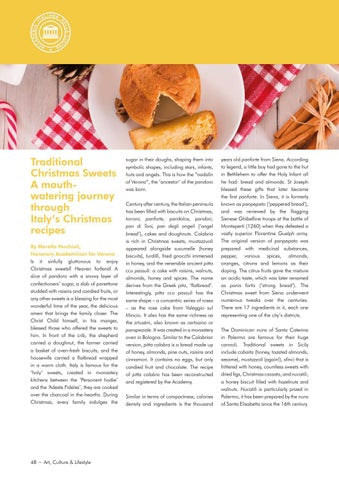Traditional Christmas Sweets A mouthwatering journey through Italy’s Christmas recipes By Morello Pecchioli, Honorary Academician for Verona Is it sinfully gluttonous to enjoy Christmas sweets? Heaven forfend! A slice of pandoro with a snowy layer of confectioners’ sugar, a slab of panettone studded with raisins and candied fruits, or any other sweets is a blessing for the most wonderful time of the year, the delicious amen that brings the family closer. The Christ Child himself, in his manger, blessed those who offered the sweets to him. In front of the crib, the shepherd carried a doughnut, the farmer carried a basket of oven-fresh biscuits, and the housewife carried a flatbread wrapped in a warm cloth. Italy is famous for the ‘holy’ sweets, created in monastery kitchens between the ‘Personent hodie’ and the ‘Adeste Fideles’, they are cooked over the charcoal in the hearths. During Christmas, every family indulges the
48 − Art, Culture & Lifestyle
sugar in their doughs, shaping them into symbolic shapes, including stars, infants, huts and angels. This is how the “nadalìn of Verona”, the ‘ancestor’ of the pandoro was born. Century after century, the Italian peninsula has been filled with biscuits on Christmas, torroni, panforte, pandolce, pandori, pan di Toni, pan degli angeli (‘angel bread’), cakes and doughnuts. Calabria is rich in Christmas sweets, mustazzuoli appeared alongside susumelle (honey biscuits), turdilli, fried gnocchi immersed in honey, and the venerable ancient pitta ccu passuli: a cake with raisins, walnuts, almonds, honey and spices. The name derives from the Greek pita, ‘flatbread’. Interestingly, pitta ccu passuli has the same shape – a concentric series of roses – as the rose cake from Valeggio sul Mincio. It also has the same richness as the zrtuséin, also known as certosino or panspeziale. It was created in a monastery oven in Bologna. Similar to the Calabrian version, pitta calabra is a bread made up of honey, almonds, pine nuts, raisins and cinnamon. It contains no eggs, but only candied fruit and chocolate. The recipe of pitta calabra has been reconstructed and registered by the Academy. Similar in terms of compactness, calories density and ingredients is the thousand
years old panforte from Siena. According to legend, a little boy had gone to the hut in Bethlehem to offer the Holy Infant all he had: bread and almonds. St Joseph blessed these gifts that later became the first panforte. In Siena, it is formerly known as panpepato (‘peppered bread’), and was reviewed by the flagging Sienese Ghibelline troops at the battle of Montaperti (1260) when they defeated a vastly superior Florentine Guelph army. The original version of panpepato was prepared with medicinal substances, pepper, various spices, almonds, oranges, citrons and lemons as their doping. The citrus fruits gave the mixture an acidic taste, which was later renamed as panis fortis (‘strong bread’). The Christmas sweet from Siena underwent numerous tweaks over the centuries. There are 17 ingredients in it, each one representing one of the city’s districts. The Dominican nuns of Santa Caterina in Palermo are famous for their huge cannoli. Traditional sweets in Sicily include cobaita (honey, toasted almonds, sesame), mustazzoli (again!), sfinci that is frittered with honey, countless sweets with dried figs, Christmas cassata, and nucatili, a honey biscuit filled with hazelnuts and walnuts. Nucatili is particularly prized in Palermo, it has been prepared by the nuns of Santa Elisabetta since the 16th century.
























